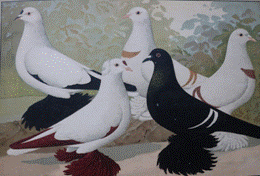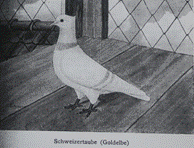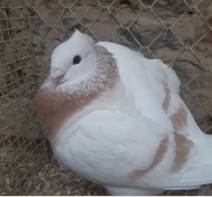|
Swiss Pigeons, Moon Pigeons, Elmers, and the Elbe
Swiss color pigeons are among the oldest color pigeons mentioned in
literature. Initially, they came in a multitude of color varieties,
some of which later became independent breeds in Switzerland. In
France, the entire range of colors was continued under the name
Swiss Color Pigeon until La Perre de Roo (1883). In Germany, since
Neumeister's publication in 1837, the name 'Swiss Pigeon' has been
restricted to color varieties with a white-atlas-like base color
with a red or yellow crescent and bars. Around 100 years ago, a
discussion arose (Wittig/Gimmel 1926) concerning the name of the
Moon Pigeon and the naming and origin of similar varieties such as
the Elbe, which also revealed to German breeders the interim
development of the breeds in Switzerland. This discussion still
provides clues today regarding the origin and relationships between
the varieties.
Swiss pigeons in Conrad Geßner's bird book, published in German by
Rudolf Heußlein in Zurich in 1557.
Heußlein (1557) lists the following as native pigeon color
variations: white, coal black (today color varieties among the
solid-colored Swiss pigeons and Lucerne Solid-Colored pigeons), and
solid red pigeons with white heads and tails (perhaps ancestors of
the Thurgau Monks, which, however, also have white wings). White
pigeons with colored tails and heads did exist. Colored tails are
found today in the Wiggertal Colored Tail, in which the head remains
white. Heußlein's white tails can be found in the Bernese, Lucerne,
and Thurgau Whitetails. Mealy-colored pigeons could already be
ancestors of the Thurgau Mealy-Colored pigeons. It is possible that
they were ancestors of the Thurgau and Lucerne Elmer pigeons. "Flour
coloured, (mealy)" or "dripped of sparrow-like" colors could refer
to cat-gray (grizzle) pigeons in the Thurgau Whitetails or to
Bernese Gugger pigeons. Pigeons with feathered feet and crests also
existed, but whether these color variations were also found in
Switzerland remains unclear in the text.
Here, one commonly finds snow-white pigeons; some are even
coal-black, others have white heads and tails. One also finds
entirely red pigeons with white heads and tails. There are also
whites with red heads and tails, or with black tails. Others are
entirely blue, or have some white on their head and tail. There
are also flour-colored, dripped, or sparrowhawk-like. Moreover,
some have broad, upright crests on their heads, which are called
Cyprian and are considered the finest. Others have completely
feathered feet down to the toes, which are said to come from
that land mentioned before.
Geßner translated from the German edition 1557
Swiss Pigeons in Buffon's French-language 'Histoire Naturelle'
(1772)
Buffon's work was translated into German as early as 1777. At the
time, the white pigeons on an atlas-like background with a
reddish-brown 'collier' were particularly striking. This translates
to a collar, which forms a colored breastplate on the breast. In
today's Swiss pigeon breeds, these are known as 'Elmer', color
variations found in Thurgau and Lucerne pigeons. In addition, there
were solid-colored pigeons and, as can be deduced from the
description, also the later Lucerne gold and copper collars. Buffon
likely meant the 'collier' to be the breastplate, not a collar.
Swiss pigeons are smaller than ordinary pigeons and no larger
than rock doves. There are several varieties, namely, red, blue,
and yellow marked on a satiny white
background, with a collar that forms a breastplate on the
chest, and which is a dark red; they often have two bars on
their wings, the same color as the breastplate. There are other
Swiss pigeons that are not variegated, etc., which are a uniform
slate-gray color all over their bodies, without a collar or
breastplate; others that are called yellow jasper collars,
meshed yellow collars; others with very meshed yellow collars,
etc., because they have collars of this color. There is also
another variety in this breed of Swiss pigeon called the azure
pigeon, because it is a bluer color than the slate-colored.
Translated from Buffon, History Naturelle, Vol. 4, 1772
Swiss Pigeons at Bechstein 1795 and Subsequent Writings
Buffon's description was adopted by Bechstein in 1795. The term
persisted in other German-language publications, such as Leopold's
in 1819. They also were called ‘necklace pigeon’ in the translation
of the French ‘collier’. Boitard and Corbié (1824), writing in
French, also referred to Buffon and presented the wide range of
color varieties as 'Pigeon Suisse'. They did not mention the peak
crest typical of most Swiss color pigeons today. The only image
shown was of a smooth-headed, smooth-legged, bronze-scaled pigeon.
Neumeister (1837) likely saw the white-atlas-type Swiss pigeons in
person and created the drawings for his book himself. He described
and illustrated only the white-atlas-type pigeons with colored
markings, already highlighted by Buffon, as Swiss pigeons. The
pigeons were described and shown plain headed and muffed
smooth-headed and had feathered feet. He also no longer called them
"necklace pigeons"; one of their names, besides "Swiss pigeon," was
"half-moon pigeon", as direct translation from German, or crescent.

The Suisse Pigeon. Source: Neumeister 1837
From the half-moon pigeon to the moon pigeon (smooth-headed and
feathered-legged) and to the ash yellow smooth-legged Elbe or Swiss
pigeon at Prütz 1885
While Neumeister still referred to it as a half-moon pigeon, Gustav
Prütz called it a moon pigeon in 1885. Smooth-headed and heavily
feathered, it came in two colorations for the bars and half-moon:
yellowish and brownish-red. Although the name no longer explicitly
mentions Swiss pigeon, the addition of C. Helvetiae establishes the
historical connection.
Besides the Moon Pigeon, Prütz describes the 'Elbe or Swiss Pigeon'.
Thus Swiss Pigeon got for him another meaning. Its smooth legs are
the main distinguishing feature. The crescent-shaped marking on the
breast is also much larger and extends further back than in the Moon
Pigeon. The genetically significant difference is easily overlooked
in a quick reading of his short description: For Prütz, the Swiss
Pigeon, after being renamed 'Elbe' (meaning bright, light), is a
very pale yellow or reddish-mealy pigeon, no longer an Atlas-like
white. It is also a distinct and attractive color variety, in which
– due to genetics – the coloration of the crescent extends into the
nape of the neck in many individuals, forming a collar. Sometimes
surrounding the neck. From genetics ash red bar of ash yellow bar
lacking modifiers required for a
satiny white background.
A neck ring is not an unusual feature in Ash red and ash yellow
(dilute ash red) pigeons. It is found today in Lucerne Ash
Yellow-Bars, but also in light ash yellows and ash reds of other
breeds. In White Moon Pigeons and Elmer Pigeons, the neck ring is
apparently masked by genetic modifiers. Many authors and
illustrators find it difficult to distinguish a light ash red from a
White Atlas-type. This also explains drawings of Moon Pigeons with
red necks, for example, by Ludlow in Fulton's book of 1876 and
identically reproduced by La Perre de Roo in 1883.
   
Moon Pigeon
yellow and Luzerne Elmer yellow at a German Show, Luzerne Elmer ash
yellow bar (breeder and photo Denis Bülow), Moon Pigeon (Swiss or
Crescent) drawn from Ludlow at Robert Fulton 1876
Many later illustrations in the literature of moon pigeons with a
pronounced collar will not have been genetically white-atlas-type
pigeons, but rather very light ash yellow or ash red pigeons, as in
Ludlow 1876 and taken over identical by La Perre de Roo 1883.
From the Swiss pigeon to the Moon pigeon with its ancestral home in
Germany, by Schachtzabel in 1910
While Prütz, with the addition of C. Helvetiae, had still linked the
origin of the White Atlas Pigeons to Switzerland, Schachtzabel names
Germany as the homeland of the Moon Pigeon on plate 43.

Red and
yellow moon pigeons in a group of color pigeons: Wing and Moon
Pigeons, as well as a Color Pigeon with white bars. Source:
Schachtzabel 1910, Plate 43
According to Schachtzabel the Moon Pigeon mistakenly is called the
Swiss pigeon. The Swiss pigeon were rarely found in Germany and the.
The base color of the moon pigeon is described as ivory, while that
of the Swiss pigeon is somewhat darker.
Schachtzabel's description of the 'Swiss Pigeon' is not shown in a
figure, but briefly described. It is not only somewhat darker than
the moon pigeon, but its neck also lacks a crescent shape. Instead,
it has a wider ring there, which extends to the back of the neck.
With this, he aligns himself with Prütz's description of the ash
yellow Elbe Pigeon and equates the Swiss pigeon with the Elbe.
Claiming to be the country of origin of a breed, or adding a
regional designation to its name, is not unusual. This occurs when
the breed is no longer kept in its original region of origin, when a
new breeding center develops regionally, or when the breed standard
is significantly altered. Examples include the German Modena, the
Modena, and the Italian Triganino Modena. The Nuremberg Bagdette was
not bred in Nuremberg either! The smooth-headed and heavily
feathered varieties of the Swiss Pigeon were probably not bred in
Switzerland. Breeding centers were located in Saxony, Thuringia, and
adjacent regions. Therefore, renaming the Swiss Pigeon to the Moon
Pigeon is not unusual; what is unusual is applying the name "Swiss
Pigeon," introduced by Neumeister in Germany, to a different color
variety (a light ash red or ash yellow with colored neck rings),
which, according to later information, did not exist in Switzerland.
O. Wittig on the Moon or Swiss Pigeon as a True Saxon Color Pigeon
In his article on the 'Moon or Swiss Pigeon' in his 1925 anthology
of breed specimens, Oswald Wittig maintains that the designation
'Swiss Pigeon' is ineradicable. He considers it a true Saxon color
pigeon, rarely bred outside the white-green border markers of
Saxony. The text distinguishes between 1. the feathered-legged 'Moon
or Swiss Pigeon' and 2. the 'South German Moon Pigeon or Golden
Elbe'. The latter is smooth-legged and has a pointed cap, unlike the
feathered-legged Moon Pigeon. Furthermore, the crescent moon on the
latter resembles a neck ring. Even the experienced breeder and judge
A. Bayer could not provide any information about the origin of the
Golden Elbe.
The illustration, however, is not consistent with the text. It shows
1. a smooth-headed, feathered-legged Moon Pigeon and 2. a "Swiss
Pigeon," which is identified in parentheses as being identical to
the Golden Elbe. In the drawing, the South German Moon Pigeon in the
text becomes the Swiss Pigeon. And this Swiss Pigeon is depicted
with the neck ring already mentioned by Prütz, which Prütz
considered typical of the clean-legged Elbe. Prütz would not have
imagined it as so distinctive, and so obviously artificial, as C.
Witzmann has drawn it here. It likely never existed in that form.
The slightly darker plumage coloration noted by Schachtzabel is also
not reflected in the illustration. The drawing was likely created
for the German book of standards for pigeons published in 1926, and
not from a living model. Apparently, not all illustrations were
compared with reality. Witzmann e.g. also mistakenly depicted the
black Thuringian Cropper with the baldhead markings of Tumblers for
this breed standard (Sell 2021).
  
Moon pigeon, yellow, Swiss pigeon (Golden Elbe) from the Anthology edited by O. Wittig, and Thurgau Elmer yellow (photo: Stauber)
A veto from Switzerland, Ernst Gimmel Jr. from Arbon Switzerland, in
the journal ‘Geflügelbörse’ 1926
Ernst Gimmel's objection to Wittig's depiction is not directed
against the renaming of the Swiss Pigeon to Moon Pigeon, but against
the portrayal of the Golden Elbe as a Swiss Pigeon. The image of the
peak-crested, clean-legged Golden Elbe corresponds to the 'Elmer'
color variety of Thurgau Field Pigeons, which Wittig seems
unfamiliar with. It is a Moon Pigeon, naturalized and bred in
Switzerland since time immemorial, which shares the exact type with
the depiction of the pigeon (Golden Elbe = 'Swiss Pigeon'), but not
the neck markings. Elmer, because pigeons with this coloration
originated in Elm. The coloration of the Moon Pigeon is thus
indirectly claimed as Swiss cultural heritage.
The mention of the coloration in Buffon's 1772 description of the
Swiss pigeon, along with other colorations still found in Swiss
pigeons today, suggests a long history of the breed's presence in
Switzerland. To avoid excessive inbreeding, a Swiss breeder
successfully introduced a feathered-legged Moon Pigeon from Germany
into his breeding program. As the genetically astute Ernst Gimmel
observes, feathered legs, pointed crests, and even differences in
build can be quickly bred in and out. This also raises the question
of whether the Saxon Moon Pigeon truly has no connection whatsoever
to the Swiss Elmer Pigeon, as Wittig seems to suggest. Perhaps the
feathered-legged variety was bred from the aforementioned "Golden
Elmer = Swiss Pigeon." Wittig himself provides evidence for a
connection between the breeds by referring to an advertisement he
discovered during recent research in the 1887 issue of the poultry
trade journal. In it, an F. Sohlst from Halle an der Saale offers
yellowish Elmer or Swiss hen pigeons for sale. The term Elmer was
therefore already common in Germany at that time.
Summary
Buffon's 1772 description of Swiss pigeons refers to characteristic
color varieties of Swiss color pigeons, some of which are still
found today. These varieties were already mentioned in 1557 in the
German version of Gessner's bird book as pigeons native to
Switzerland. In Germany, Neumeister restricted the term "Swiss
pigeon" in 1837 to the white-atlas-like pigeons highlighted by
Buffon, with a reddish-brown or yellow crescent on the breast. They
were shown with feathered feet and a smooth head. In 1885, Prütz no
longer referred to them as Swiss pigeons or crescent pigeons, but
rather as moon pigeons. He gave the name Swiss pigeon (Elbe or Swiss
pigeon) to a pigeon with a light ash red- or ash yellow coloration.
Besides the coloration, a difference from the moon pigeon were its
clean feet and the larger neck ring, which widens further towards
the rear.
Perhaps also due to lacking knowledge of the Swiss breeds, and also
of genetics, Schachtzabel and Wittig wanted to establish the neck
ring for Swiss pigeons as a general difference to the Saxon Moon
Pigeons. This was supported by a drawing by C. Witzmann for Wittig‘s
anthology (1925) and the then coming German Book of Standards
(1926), which was clearly not based on nature. The response from
Switzerland showed that the Moon Pigeons kept in Switzerland, under
the name Elber, have possessed the color pattern of the Moon Pigeon
on a white-atlas-like background since time immemorial. Since
pointed crests, leg feathers, and body characteristics can be
quickly bred out, close relationships between the breeds must exist.
This could make it also possible to trace the feathered,
smooth-headed Moon Pigeons back to Swiss Moon Pigeons.
In Germany today, plain-headed/muffed pigeons are distinguished as
Saxon Moon Pigeons, and plain-headed/clean-legged ones as Thuringian
Moon Pigeons. Among Swiss color pigeons, there is the Thurgau Elmer
with peak crests and the Lucerne Elmer with peak crests and groused
feets.
Literature:
Bechstein, Johann Matthäus, Gemeinnützige Naturgeschichte
Deutschlands nach allen drey Reichen, Vierter Band, Leipzig 1795
Boitard, Pierre, et Corbié, Les Pigeons de volière et de colombier
ou histoire naturelle et monographie des pigeons domestiques, Paris
1824.
Buffon, Georges Louis Leclerc de, Herrn von Buffons Naturgeschichte
der Vögel, übersetzt durch F.H.W. Martini, 6.
Band, Berlin 1777.
Buffon, Georges Louis Leclerc de, Oeuvres complètes, Band IV, Paris
1772.
Fulton, Robert, The Illustrated Book of Pigeons, London u.a. 1876.
Gesner, Conrad, Vogelbuch. Darin die art/natur und eigenschafft
aller vöglen / sampt jrer waren Contrafactur / angezeigt wirt: ...
Erstlich durch doctor Conradt Geßner in Latein beschriben: neüwlich
aber durch Rudolff Heüßlin mit fleyß in das Teütsch gebracht / und
in ein kurtze ordnung gestelt, Getruckt zu Zürich bey Christoffel
Froschouwer im Jar als man zalt M.D.LVII (1557)
Ilgen, Horst, und Bernd Herbold, 100 Jahre Sonderverein der
Thüringer Farbentauben. Chronik 1910-2010, Amadeus Verlag,
Sonnenberg 2010.
La Perre de Roo, V., Monographie des Pigeons Domestic, Paris 1883
Leopold, Just Ludwig Günther, Der Taubenfreund oder kurzgefaßter
Gesammtunterricht in der Taubenzucht, Sonderhausen 1819
Neumeister, Gottlob, Das Ganze der Taubenzucht, Weimar 1837
Prütz XE "Prütz"
, Gustav, Illustrirtes Mustertaubenbuch, Hamburg, o.J. (1885)
Schachtzabel, E., Illustriertes Prachtwerk sämtlicher Tauben-Rassen,
Würzburg o.J. (1910)
Sell, Axel and Jana Sell, Genetik der Haustaube, Achim 2025
Sell, Axel, Vorsicht Künstler. Thüringer gemönchte Kröpfer, in:
Verständnis und Missverständnisse in der Taubenzucht. Anekdotische,
unterhaltsame und lehrreiche Anmerkungen zu offenen Fragen, Teil VI,
Achim 2021, S. 24-26
Stauber, Karl, Schweizer Tauben. Herkunft, Zucht, Standard,
Oberentfelden 1996
Wittig, Oswald, Die Goldelbe, Geflügelbörse vom 5. Nov. 1926
(discussion with Ernst Gimmel jun., from Arbon, Switzerland)
Wittig, Oswald, Unser Hausgeflügel. Zweiter Teil Mustertaubenbuch.
I. Teil: Die Farben und Trommeltauben, Berlin 1925
Annex:
 
Brown and yellow, or red and yellow.
The designation for both Swiss and German Moon Pigeons fluctuated
between brown and red in written documents and breed standards. In
the publication for the 100th anniversary Thuringian Color Pigeon
Breeders' Association, the color varieties are still referred to as
brown and red (Ilgen/Herbold 2010). Andreas Leiß has determined
through genetic experiments with Thurgau Elmers that these are
dominant reds, whose base plumage is lightened by a modifier that
only works on a red base color.
Source: Lucerne Elmer red, breeding and photo by Denis Bülow,
Thuringian Moon Pigeons in the book of Ilgen/Herbold 2010
  
Similarities.
Similar neck markings in a homing pigeon 'Cherry' from own breeding
stock, a light ash yellow-bar Dragoon at an exhibition, and an
ash-yellow-bar Lucerne hen, photo and owner to Denis Bülow.
|